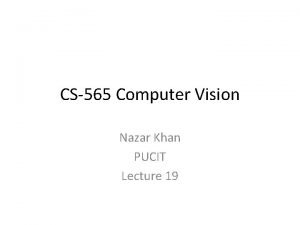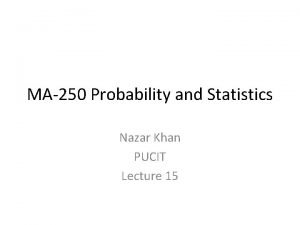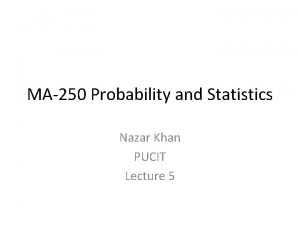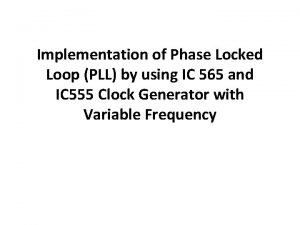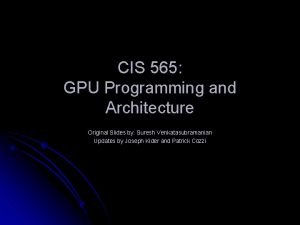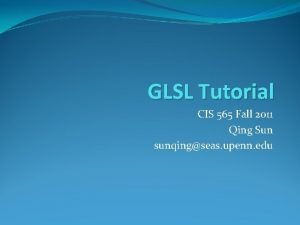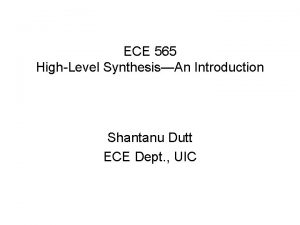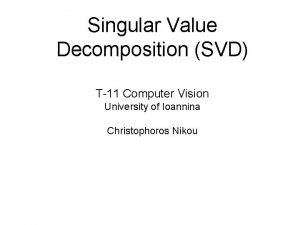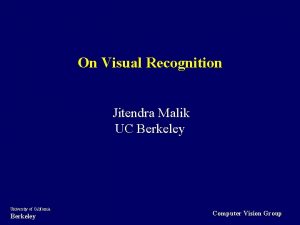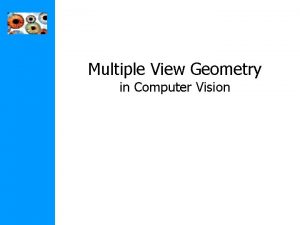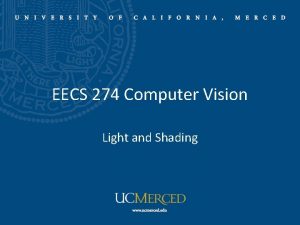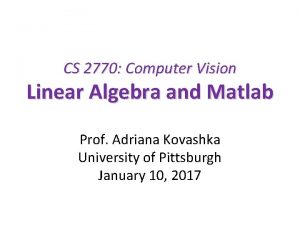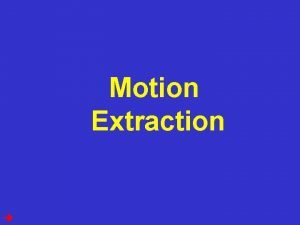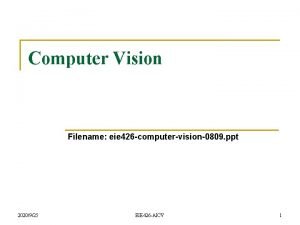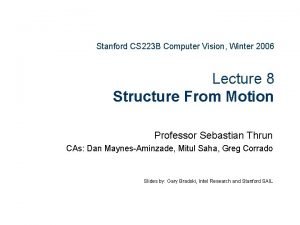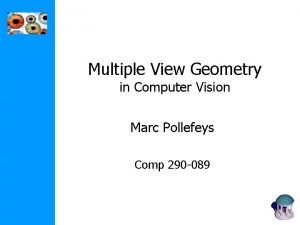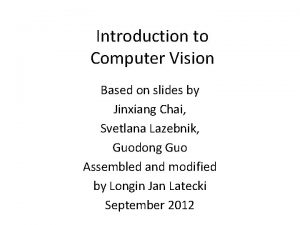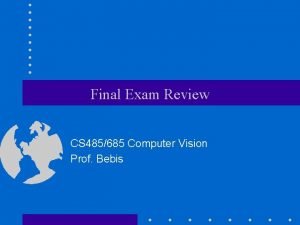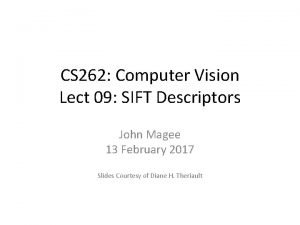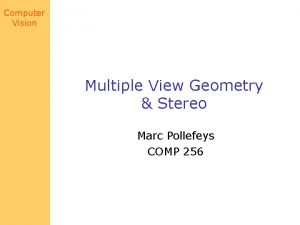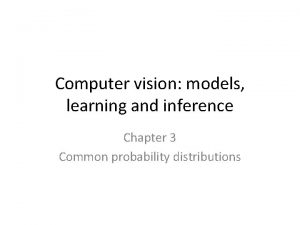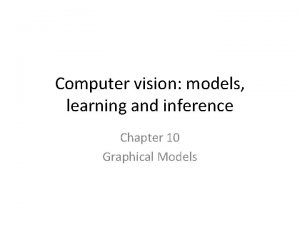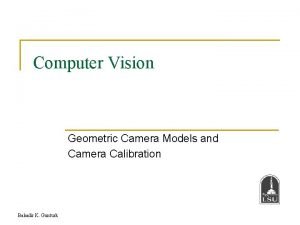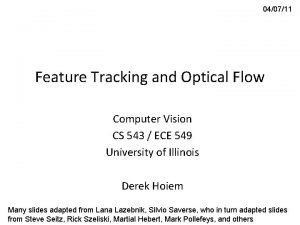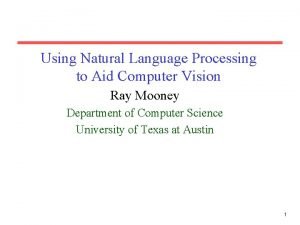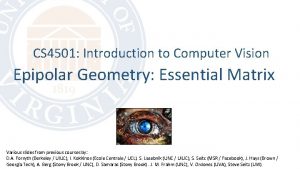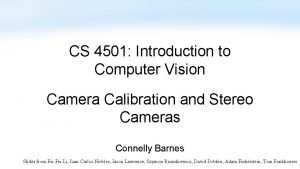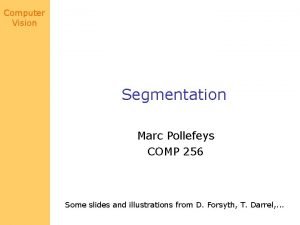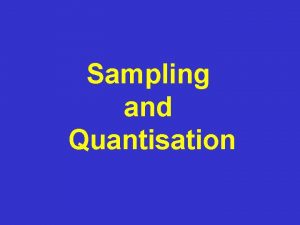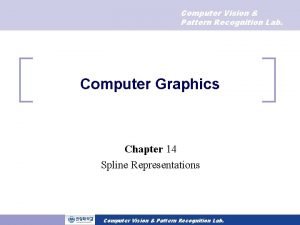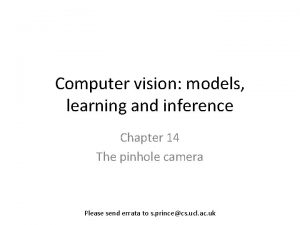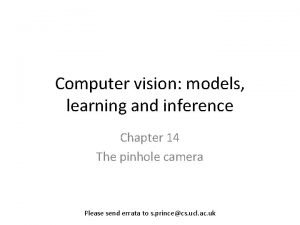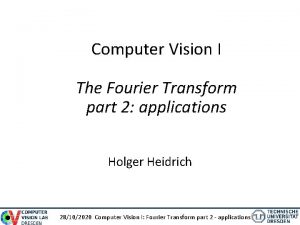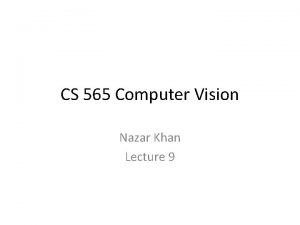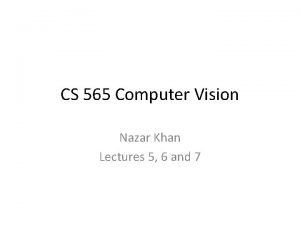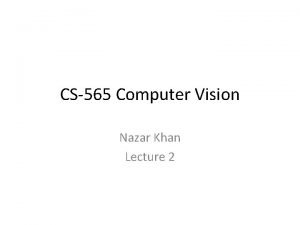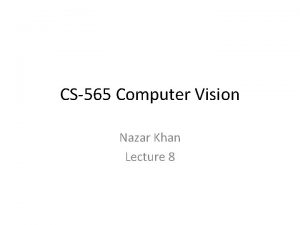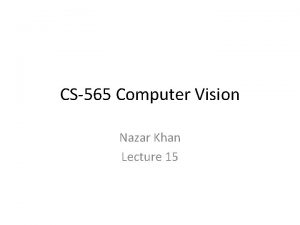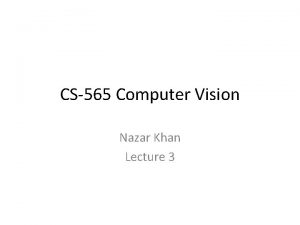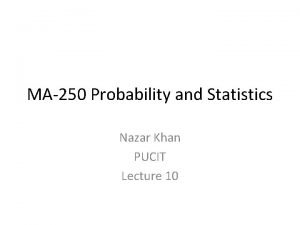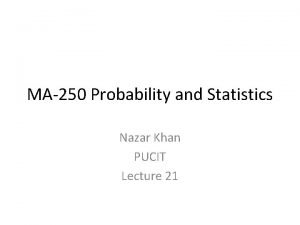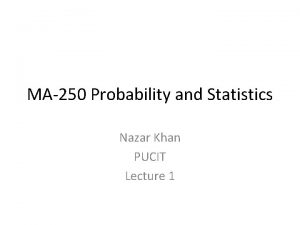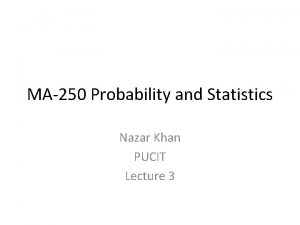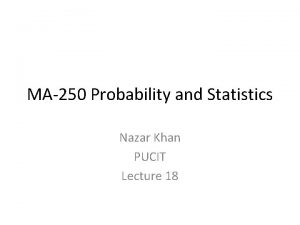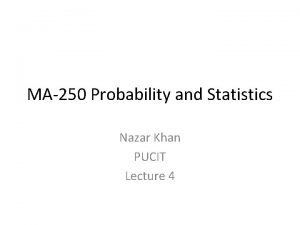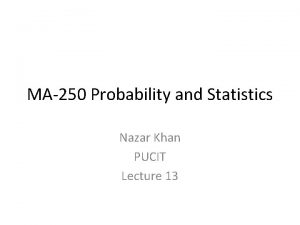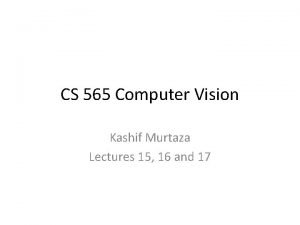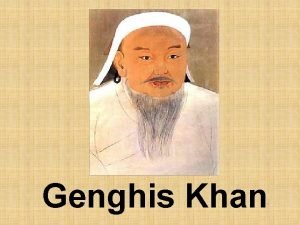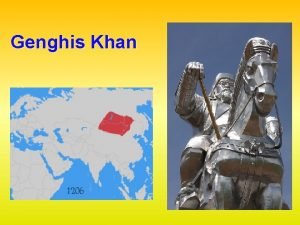CS 565 Computer Vision Nazar Khan Lecture 11






















































- Slides: 54

CS 565 Computer Vision Nazar Khan Lecture 11


What is a Corner? • A corner may be interpreted as an intersection of two edges, or as a region where strong derivatives exist in more than one direction

Corner Detection • The gradient vector is sufficient to give the local structure information for an edge. • For corners, the local structure direction around the corner changes strongly. – This suggests that corner phenomenon requires looking in a neighbourhood. • We want to find the directions of largest/smallest grayvalue changes within a neighbourhood. • This requires integration of directional information over a neighbourhood.

Corner Detection • Let ∇u be the gradient direction. • A vector n that is orthogonal to ∇u satisfies n. T∇u=0. • Let us average the gradient ∇u. N vectors in a certain neighbourhood N. – ∑N ∇u • A vector n that is “most orthogonal” to the average gradient direction within a neighbourhood N • Is a minimiser of E(n)=∑N (n. T∇u)2

Corner Detection E(n) = = where A ∑N (n. T∇u)2 ∑N n. T∇u∇u. Tn n. T (∑N ∇u∇u. T ) n n. T An = ∑N ∇u∇u. T = [ux 2 uxuy ; uxuy uy 2].

Some Linear Algebra • Let n be a unit vector. • n. T An is projection of n onto An • This projection will be maximum when An has the same direction as n. • Vectors n for which An has the same direction are known as eigen-vectors of A. – An=λn where λ is the eigen-value corresponding to the eigen-vector n. – For the largest eigen-value of A, n. T An = λ 1. – For the smallest eigen-value of A, n. T An = λ 2.

Structure Tensor The matrix of summations A = ∑N ∇u∇u. T = [ ∑N u x 2 ∑N u x u y ] [ ∑N u x u y ∑N u y 2 ] is often replaced by the matrix of Gaussian averages Jρ = Kρ * (∇u∇u. T) [ Kρ*ux 2 Kρ*(uxuy) ] [ Kρ*(uxuy) Kρ*uy 2 ] which is the so-called structure tensor. Captures changes in local structure around a point.

Structure Tensor • The structure tensor Jρ is – Symmetric – Positive definite • Its orthonormal eigenvectors v 1, v 2 specify the directions of largest/smallest contrast within some integration scale ρ. • The corresponding eigenvalues λ 1, λ 2 describe the average contrast along these directions. • Let λ 1>= λ 2. The eigenvalues allow a useful analysis of the local image structure: – – constant areas: λ 1 = λ 2 = 0 straight edges: λ 1 >> λ 2 = 0 corners: λ 1 >= λ 2 >> 0 measure of anisotropy: (λ 1 - λ 2)2















Harris Corner Detector • Approximation 24

25

26

27

28

29



Corner Detection – A Second Look • A corner is different from its surroundings. • A patch placed on a corner pixel is different from its surrounding patches. Patch is similar to patches in all directions Patch is similar to patches in vertical direction Patch is similar to patches in horizontal direction Patch is NOT similar to patches in all directions

+ + - Demo of a point + with well distinguished neighbourhood. >0

+ + - Demo of a point + with well distinguished neighbourhood. >0

+ + - Demo of a point + with well distinguished neighbourhood. >0

+ + - Demo of a point + with well distinguished neighbourhood. >0

+ + - Demo of a point + with well distinguished neighbourhood. >0

+ + - Demo of a point + with well distinguished neighbourhood. >0

+ + - Demo of a point + with well distinguished neighbourhood. >0

+ + - Demo of a point + with well distinguished neighbourhood. >0

Patch Similarity • Similarity of two patches p and q can be computed via the sum-of-squared-differences (SSD). • SSD(p, q)=∑(pij-qij)2

Moravec Corner Detector • Among the early corner detection approaches. • Basic Idea: A corner should have low selfsimilarity. – Self-similarity: how similar a patch is to neighbouring, overlapping patches. • Corner Strength: min(SSD(p, q. N )) – If p is different from its neighbours in all directions, then this min value will be large. • If corner strength at a pixel is locally maximal, then this pixel is a corner.

Moravec Corner Detector • Weakness: If an edge is not aligned with the directions we are looking in, then this edge will be falsely detected as a corner. Directions that we look in Patch is NOT similar to patches in all directions that we look in. So it will be detected as a corner instead of an edge pixel.

Harris Corner Detector • Solution: – Do not fix the directions that we are looking in. – Find the direction in which patches become most dissimilar. • That is, the direction that maximises the SSD from current patch.

Harris Corner Detector d* H. W. : Prove that these two expressions are equivalent.

Harris Corner Detector d*

Harris Corner Detector d*

Harris Corner Detector • What is the difference between d* and gradient direction u? – Gradient u is for a pixel. – d* is for a patch. d*

Harris Corner Detector • For an edge, the direction orthogonal to d* will be the direction of least change in our weighted SSD. – From S(d)=d. TAd= , the weighted SSD in direction d* is given by the corresponding eigenvalue. • Since the structure tensor A is symmetric, positive definite, its eigenvectors will be orthonormal. • So the direction of least change in weighted SSD is given by the 2 nd eigenvector of A. – the weighted SSD in this direction is given by the corresponding eigenvalue. • If this eigenvalue is large, then we have a nonedge/corner.

Harris Corner Detector • If the smaller eigenvalue is large, then we have a non-edge/corner. • large small 0 flat region • large>> small 0 edge • large and small >> 0 corner

Harris Corner Detector Author: Nazar Khan (2014)

Harris Corner Detector V 1 V 2 Corner Author: Nazar Khan (2014)

Harris Corner Detector V 1 V 2 Corner Author: Nazar Khan (2014)

Corner Detection • H. W: Write a detailed derivation/explanation of the Harris corner detector starting from the Moravec corner detector. • H. W: Implement a simple Harris corner detector using the rule small>T and test it on some sample real-world image. – Experiment with other corner measures: • Haris & Stpehens • Shi-Tomasi • Nobel
 Nazar khan pucit
Nazar khan pucit Diced%20mangos
Diced%20mangos Nazar khan pucit
Nazar khan pucit Structured light
Structured light Colegio benito nazar
Colegio benito nazar Hakim yang bertugas di mahkamah an nazar fil mazalim
Hakim yang bertugas di mahkamah an nazar fil mazalim Bruno palazzo nazar
Bruno palazzo nazar 01:640:244 lecture notes - lecture 15: plat, idah, farad
01:640:244 lecture notes - lecture 15: plat, idah, farad 565 ic pin diagram
565 ic pin diagram 560*.75
560*.75 Cis 565
Cis 565 Yed-565
Yed-565 Cad output devices
Cad output devices Cs 565
Cs 565 Cis 565
Cis 565 Ece 565
Ece 565 Cse 3541
Cse 3541 Computer security 161 cryptocurrency lecture
Computer security 161 cryptocurrency lecture Computer aided drug design lecture notes
Computer aided drug design lecture notes Computer architecture lecture notes
Computer architecture lecture notes Microarchitecture vs isa
Microarchitecture vs isa 16385 cmu
16385 cmu Kalman filter computer vision
Kalman filter computer vision T11 computer
T11 computer Berkeley computer vision
Berkeley computer vision Multiple view geometry
Multiple view geometry Computer vision vs image processing
Computer vision vs image processing Radiometry in computer vision
Radiometry in computer vision Linear algebra for computer vision
Linear algebra for computer vision Impoverished motion examples
Impoverished motion examples Computer vision: models, learning, and inference
Computer vision: models, learning, and inference Watershed segmentation
Watershed segmentation Computer vision stanford
Computer vision stanford Multiple view geometry in computer vision
Multiple view geometry in computer vision Azure computer vision python
Azure computer vision python Mathematical foundations of computer graphics and vision
Mathematical foundations of computer graphics and vision Computer vision slides
Computer vision slides Ilsvrc 2012 dataset
Ilsvrc 2012 dataset Computer vision final exam
Computer vision final exam Computer vision sift
Computer vision sift Multiview geometry in computer vision
Multiview geometry in computer vision Computer vision: models, learning, and inference
Computer vision: models, learning, and inference Computer vision: models, learning, and inference pdf
Computer vision: models, learning, and inference pdf Geometric camera calibration
Geometric camera calibration Aperture problem computer vision
Aperture problem computer vision Computer vision vs nlp
Computer vision vs nlp Epipolar geometry computer vision
Epipolar geometry computer vision Computer vision camera calibration
Computer vision camera calibration Computer vision
Computer vision Sampling in computer vision
Sampling in computer vision Computer vision
Computer vision Computer vision
Computer vision Computer vision
Computer vision Computer vision
Computer vision Fourier transform in computer vision
Fourier transform in computer vision
